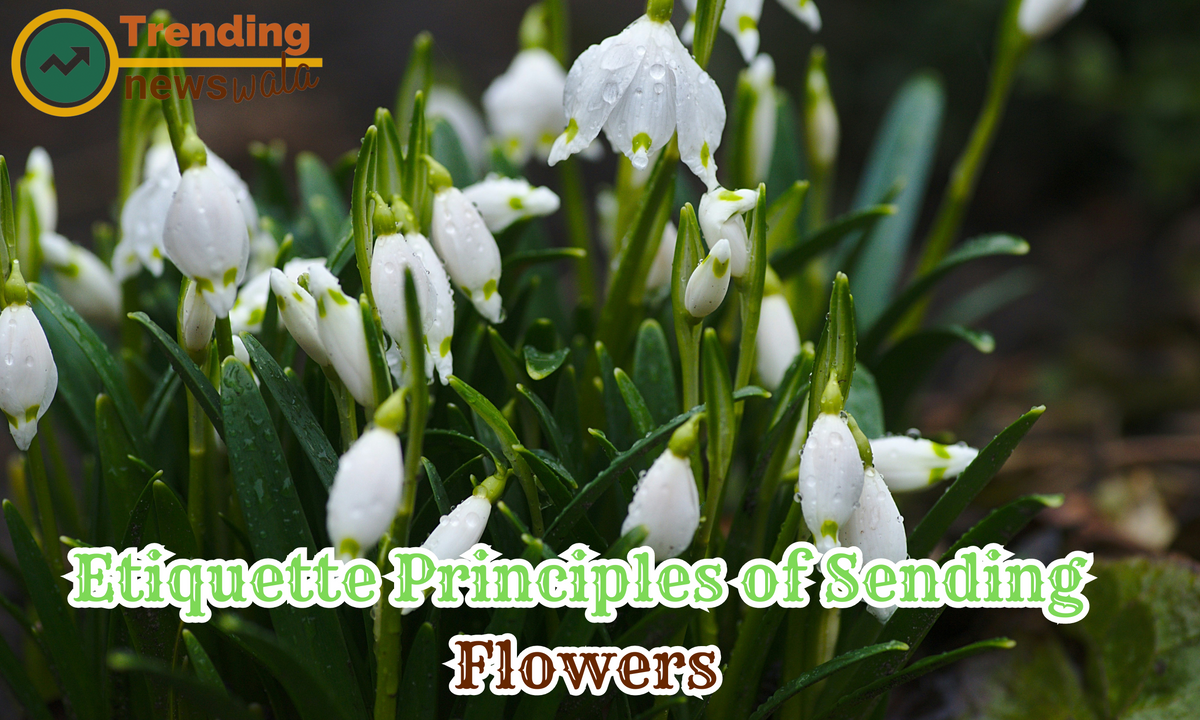Etiquette Principles of Sending Flowers

There are many reasons why people purchase flowers online and get them delivered via a courier. Wishing someone a happy birthday, congratulating a coworker on their professional achievement, sharing sympathy, or expressing appreciation toward a special person – fresh flowers express feelings louder than words.
Still, when you are looking for International flowers online, knowing bouquet giving etiquette is very important because you never want your fresh flower arrangement to convey a wrong message or wound someone’s susceptibilities. Here are some handy tips on how to observe etiquette rules for a variety of occasions when ordering flowers online.
Colors Matter

Certainly! The phrase "Colors Matter" can be interpreted in various contexts, each with its own significance. Here are a few perspectives:
Visual Arts and Design: In the realm of visual arts, colors are a powerful tool for expression and communication. Different colors evoke specific emotions and convey meanings. Artists and designers often use color palettes strategically to create mood, highlight focal points, or evoke a particular atmosphere. For example, warm colors like red and orange may signify energy and passion, while cool colors like blue and green might evoke calmness and serenity.
Branding and Marketing: In the business world, the choice of colors is crucial in branding and marketing. Brands carefully select colors that align with their identity and target audience. For instance, a tech company might opt for sleek and modern colors, while a health-related brand might choose calming and reassuring hues. Colors play a significant role in influencing consumer perception and brand recognition.
Cultural Symbolism: Colors often hold cultural significance and symbolism. In different cultures, colors can represent various emotions, traditions, or societal values. For example, in some cultures, white symbolizes purity and peace, while in others, it may represent mourning. Understanding the cultural context of colors is important to avoid misinterpretations.
Psychology of Colors: The psychology of colors explores how different colors can impact human emotions and behavior. For instance, studies suggest that warm colors can increase energy levels and stimulate appetite, making them suitable for restaurants. Understanding color psychology is applied in various fields, including interior design, healthcare, and even educational environments.
Environmental Impact: In discussions about environmental sustainability, the colors matter in terms of the materials and pigments used in products. Eco-friendly practices may involve using natural dyes or reducing the use of harmful chemicals in the manufacturing process. Additionally, color choices in architecture and urban planning can impact the environmental aesthetics of a space.
Social and Political Movements: Colors can also be symbolic in social and political contexts. Certain colors are often associated with specific movements or causes. For example, the LGBTQ+ pride flag features a spectrum of colors symbolizing diversity and inclusivity. In political movements, colors may represent solidarity and unity.
Personal Expression: On a personal level, the colors we choose to wear or surround ourselves with can be a form of self-expression. Some people are drawn to certain colors because they find them visually appealing, while others may choose colors based on their mood or the message they want to convey.
In summary, the phrase "Colors Matter" encompasses a broad range of meanings, from artistic expression and branding strategies to cultural symbolism and personal choices. The impact of colors extends across various aspects of our lives, influencing our perceptions, emotions, and interactions with the world around us
While it is up to you to choose flowers in any tint, it is in your best interest to be aware of common traditions regarding flower colors. If your recipient is celebrating a joyous event, it is great to pick blooms in bright and festive colors. If the occasion is formal or even somber, a good rule of thumb is to opt for floral arrangements with white or pale blooms.
Your appreciation and romance can be excellently expressed with pink or red flowers. A thank-you bouquet should be composed of your recipient’s favorite colors to emphasize the person’s importance in your life. The meaning of flower colors varies across different cultures, so make sure your bouquet conveys the right message to a person of a different religion or outlook than yours.
Valentine's Day

Certainly! Valentine's Day, celebrated annually on February 14th, is a day dedicated to expressing love and affection between intimate companions. The day is named after St. Valentine, a Christian martyr who lived during the Roman Empire. Over the years, Valentine's Day has evolved into a celebration of romantic love, marked by the exchange of cards, flowers, gifts, and special gestures.
History and Origin: The origin of Valentine's Day is associated with various historical and legendary accounts. One popular story suggests that St. Valentine, a Roman priest, defied Emperor Claudius II's ban on marriages for young men. St. Valentine continued to perform marriages in secret, leading to his arrest and eventual execution. Other stories connect Valentine's Day to Roman and pagan fertility festivals.
Cultural Traditions: Valentine's Day is celebrated in many countries around the world, although customs and traditions may vary. In some cultures, it is a day for expressing love not only to romantic partners but also to friends and family members.
Expressions of Love: People express their love and affection on Valentine's Day through various means. This often includes the exchange of Valentine's Day cards, flowers (especially roses, symbolizing love), chocolates, and gifts. Romantic dinners and special outings are also common.
Love Notes and Poetry: Writing love notes, letters, or poems is a classic way to convey heartfelt feelings on Valentine's Day. Many people take the opportunity to express their emotions creatively through written words.
Romantic Dinners and Getaways: Restaurants and hotels often offer special Valentine's Day packages, including romantic dinners, weekend getaways, and spa treatments. Couples take advantage of these opportunities to create memorable experiences.
Gift-Giving: Gifts exchanged on Valentine's Day can range from small tokens of affection to more elaborate presents. Common gift ideas include jewelry, perfumes, personalized items, and thoughtful keepsakes.
Digital Expressions: With the rise of digital communication, expressions of love on Valentine's Day have extended to social media, where people share photos, messages, and virtual greetings. Digital cards and online shopping have also become popular.
Galentine's Day: In recent years, there has been a growing trend of celebrating "Galentine's Day" on February 13th. This day is dedicated to celebrating the bonds of friendship among women, often involving gatherings, brunches, and gift exchanges.
Anti-Valentine's Day: Some individuals, whether single or not, may choose to reject or humorously mock the commercial aspects of Valentine's Day. Anti-Valentine's Day events or parties may be organized as a form of alternative celebration.
Cultural Variations: Different cultures may have unique traditions associated with expressing love. In some places, Valentine's Day is celebrated with cultural performances, parades, or religious ceremonies.
Overall, Valentine's Day is a day to celebrate and appreciate love in its various forms. Whether through romantic gestures, friendship celebrations, or personal reflections, individuals find different ways to make the day special for themselves and their loved ones
Valentine’s Day basks in flowers! Red roses, pink peonies, and carnations reign supreme during this period, but primroses, chrysanthemums, and tulips also make lovely choices. Red is strongly associated with passion, love, and desire, but pink and white tints also communicate tender feelings of yours toward a recipient.
Mother's Day

Certainly! Mother's Day is a special occasion dedicated to honoring and celebrating mothers, motherhood, and maternal bonds. It is a day to express gratitude and love for the mothers, grandmothers, stepmothers, and other maternal figures in our lives. Mother's Day is celebrated in various countries around the world, although the dates may differ.
Origin and History: The modern celebration of Mother's Day has its roots in the early 20th century. The efforts of Anna Jarvis, an American woman, played a significant role in establishing Mother's Day as an official holiday. The first Mother's Day was celebrated in 1908, and it became an official holiday in the United States in 1914.
Date of Celebration: The date of Mother's Day varies in different countries. In the United States, Mother's Day is celebrated on the second Sunday of May. However, in the United Kingdom, Mothering Sunday is observed on the fourth Sunday of Lent.
Expressions of Love: Mother's Day is a time for expressing love and appreciation. People often convey their feelings through cards, flowers, gifts, and thoughtful gestures. Handwritten notes, homemade gifts, and acts of service are common ways to show gratitude.
Gift-Giving: Gift-giving is a significant aspect of Mother's Day. Common gifts include flowers, chocolates, jewelry, personalized items, spa treatments, and special outings. The choice of gifts often reflects the interests and preferences of the recipient.
Quality Time: Spending quality time with mothers is highly valued on Mother's Day. Many families choose to celebrate by having a special meal together, whether at home or at a restaurant. Some may plan outdoor activities, picnics, or family gatherings.
Honor for Maternal Figures: Mother's Day extends beyond biological mothers. It is also a time to honor stepmothers, grandmothers, aunts, and other maternal figures who play important roles in individuals' lives. The emphasis is on recognizing and appreciating all forms of maternal care and support.
Digital Celebrations: In the age of digital communication, Mother's Day celebrations often include virtual elements. Phone calls, video calls, and social media posts become means of expressing love and connecting with mothers, especially for those who may be geographically distant.
Charitable Activities: Some people choose to engage in charitable activities on Mother's Day, contributing to causes that support mothers and families in need. This can include donations to maternal health organizations or volunteering at local charities.
Mother's Day Brunches and Events: Many restaurants and event venues offer special Mother's Day brunches, lunches, or events. These gatherings provide an opportunity for families to celebrate together in a festive atmosphere.
Cultural Variations: While the essence of Mother's Day remains consistent, different cultures may have unique customs and traditions associated with the celebration. In some cultures, Mother's Day may be linked to religious or historical events.
Mother's Day serves as a heartfelt reminder to acknowledge and appreciate the love, sacrifices, and nurturing that mothers provide. It is a time to celebrate the profound impact mothers have on individuals, families, and society as a whole
When Mother's Day is on the threshold in the spring, sons and daughters of all ages raid local florist shops to buy the best bouquet for the best mom on the planet. Mother's Day floral arrangements are easy to personalize, and they can be complemented with sweet treats to your mommy’s liking.
Expressing Sympathy

Expressing sympathy is an important aspect of offering comfort and support to someone who is experiencing grief or loss. It involves conveying genuine condolences and empathy to provide solace during difficult times. Here are more details on expressing sympathy:
Timeliness: It's crucial to express sympathy promptly after learning about someone's loss. Sending a message or reaching out soon after the news is received demonstrates compassion and immediate support during the initial stages of grief.
Choosing the Right Words: Finding the right words can be challenging, but it's essential to express sincere and heartfelt condolences. Use gentle and empathetic language, acknowledging the person's pain and loss. Avoid clichés and instead offer genuine sentiments.
Personalized Messages: Personalize your message by recalling specific memories or qualities about the person who has passed away. Sharing personal anecdotes or stories can provide comfort and demonstrate a deep connection.
Listening and Empathy: When expressing sympathy in person or through messages, be a good listener. Sometimes, the grieving person may want to share their feelings, and your willingness to listen without judgment is a valuable form of support.
Offering Assistance: Extend practical assistance by offering specific help, such as preparing meals, running errands, or assisting with household chores. Concrete offers of support can ease the burden on the grieving individual during a challenging time.
Sending Sympathy Cards: Sending a sympathy card is a traditional way to express condolences. Choose a card with a thoughtful message or write a personal note to convey your sympathy. Handwritten messages often carry a special touch.
Attending Services: If possible and appropriate, attend memorial services, funerals, or memorial gatherings to show your support in person. Your presence can be a source of comfort for the grieving family.
Virtual Support: In today's digital age, expressing sympathy can also occur through virtual means. Sending an email, text message, or expressing condolences on social media can be meaningful, especially if in-person contact is not possible.
Respecting Cultural Practices: Be aware of and respect the cultural or religious practices of the grieving person. Different cultures have specific traditions and rituals related to mourning, and understanding these practices can guide your expressions of sympathy.
Continued Support: Grieving is a process that takes time, and ongoing support is valuable. Continue to check in on the grieving individual in the days, weeks, and months following the loss. Small gestures of kindness and consistent presence can make a significant impact.
Sending Flowers or Gifts: Sending flowers or a sympathy gift can be a thoughtful way to express condolences. Ensure that the chosen flowers or gifts align with the preferences and cultural considerations of the grieving family.
Remember that expressing sympathy is not about finding solutions or alleviating the pain completely. It's about showing genuine care, empathy, and a willingness to offer support during a difficult period. Every individual grieves differently, so being sensitive to the needs of the person experiencing loss is crucial
Choosing a sympathy bouquet can be tricky because some families will not prefer to receive tons of flowers from friends and relatives, but request them to make charitable donations instead. Before ordering a sympathy flower arrangement online, try to find out about a family’s wishes regarding flowers on that sorrowful day.
Traditionally, sympathy flowers are meant to pay respect to all the good the deceased person did when was alive. So try to pick thoughtful flowers that signify the best characteristics of a passed person: courage, optimism, friendliness, etc. White blooms are a timeless classic for sympathy floral arrangements, but some people also choose dark blue or even black flowers as a token of their deep compassion.
Sending Get Well Soon Flowers

Sending get well soon flowers is a thoughtful and caring gesture to express your wishes for a speedy recovery to someone who is unwell. Flowers have the power to brighten up a space, lift spirits, and convey warmth and support. Here are more details on sending get well soon flowers:
Choice of Flowers: Selecting the right flowers is important. Bright and cheerful blooms are often preferred, such as sunflowers, daisies, lilies, or vibrant mixed bouquets. Consider the recipient's favorite flowers or colors to personalize the arrangement.
Meaningful Messages: Include a heartfelt get well soon card with a personalized message. Express your well wishes and let the recipient know that you are thinking of them during their recovery. A thoughtful message can provide comfort and encouragement.
Considerate Arrangements: Choose flower arrangements that are easy to care for and don't require a lot of maintenance. Opt for bouquets with long-lasting flowers and greenery. Consider including a vase if the recipient may not have one readily available.
Balancing Fragrances: Be mindful of the fragrance of the flowers. While many people enjoy the scent of fresh flowers, some individuals may be sensitive to strong fragrances, especially if they are unwell. Select flowers with a mild and pleasant scent or opt for unscented varieties.
Bright and Cheerful Colors: Bright and cheerful colors can have a positive impact on a person's mood. Consider vibrant hues like yellow, orange, or pink to bring a sense of joy and energy to the recipient's environment.
Long-Lasting Blooms: Choose flowers that have a longer lifespan. Carnations, chrysanthemums, and alstroemerias are examples of flowers known for their longevity. This ensures that the recipient can enjoy the flowers for an extended period.
Thoughtful Additions: Consider adding thoughtful additions to the flower arrangement, such as a small stuffed animal, a get well soon balloon, or a care package with comforting items like tea, honey, or soothing scents.
Delivery Logistics: Coordinate the delivery of the flowers to ensure they reach the recipient at an appropriate time. Check if the hospital or the recipient's home has any restrictions or guidelines regarding flower deliveries.
Respecting Dietary Restrictions: If you plan to include any edible items in the arrangement, be aware of the recipient's dietary restrictions or preferences. Opt for items that are easy on the stomach and suitable for someone who may not be feeling well.
Consideration of Health Conditions: Take into account any health conditions the recipient may have. For example, if the person is allergic to specific flowers, it's important to choose blooms that won't trigger allergies.
Sensitivity to Cultural Practices: Be mindful of cultural practices or beliefs regarding gifts and flowers. Some cultures may have specific preferences or traditions that should be considered when sending get well soon flowers.
Sending get well soon flowers is a gesture that shows you care and provides comfort to someone going through a challenging time. It's a simple yet meaningful way to convey your wishes for their recovery and well-being
It is quite natural that you want to send a vivacious bouquet to someone ill to cheer up their spirits. When they are bedridden or unable to leave the house, having a bright bouquet around can be very comforting. However, be aware that due to allergies, risk of infection, etc., many hospitals do not allow flowers to be placed inside patients’ wards. You should always study hospital policies before sending a fresh bouquet there. It is generally more polite to wait until the person is back to the privacy of their home to send them a lovely Get Well Soon arrangement.
Sending Personal Occasion Flowers

Certainly! Sending flowers for personal occasions is a beautiful and thoughtful way to celebrate and convey emotions on special days. Whether it's a birthday, anniversary, graduation, or any other personal milestone, flowers add a touch of elegance and warmth to the occasion. Here are more details on sending flowers for personal occasions:
Choosing Appropriate Flowers: Consider the recipient's preferences and the nature of the occasion when choosing flowers. Different blooms carry various meanings and convey distinct emotions. For example, roses are often associated with love, while lilies represent purity and elegance. Choose flowers that align with the sentiment of the occasion.
Personalized Arrangements: Personalize the flower arrangement to reflect the recipient's taste and style. If you know their favorite flowers or colors, incorporate them into the bouquet. Adding personal touches makes the gift more meaningful and thoughtful.
Symbolic Colors: Pay attention to the symbolic meanings of flower colors. Each color can convey a different message. For instance, red symbolizes love and passion, while yellow represents joy and friendship. Choose colors that resonate with the occasion and the recipient's personality.
Meaningful Flower Combinations: Combine different flowers to create a meaningful arrangement. For example, you could combine roses for love, daisies for innocence, and orchids for beauty to create a bouquet with a well-rounded message.
Arrangement Styles: Consider the style of the flower arrangement. For a romantic occasion, a bouquet with long-stemmed roses might be appropriate. A more casual and rustic arrangement, perhaps with wildflowers, could be suitable for a laid-back celebration.
Accompanying Gifts: Pair the flower arrangement with accompanying gifts to enhance the overall celebration. This could include a handwritten card, chocolates, a bottle of wine, or any other items that the recipient would appreciate. The combination of flowers and thoughtful gifts adds a special touch.
Thoughtful Card Messages: Write a thoughtful card message expressing your sentiments. Whether it's a heartfelt birthday wish, a congratulatory note, or a message of love, your words can enhance the emotional impact of the flowers.
Delivery Considerations: Plan the delivery of the flowers to coincide with the special occasion. Consider whether the recipient would prefer a surprise delivery or if they would appreciate having the flowers arrive at a specific time during the celebration.
Budget-Friendly Options: There are various budget-friendly options for sending flowers. Opt for seasonal blooms or smaller arrangements that still convey the same sentiment. Many florists offer a range of options to suit different budgets.
Sustainability Considerations: If environmental sustainability is important to you or the recipient, inquire about eco-friendly and sustainable flower options. Some florists offer arrangements with locally sourced and environmentally conscious blooms.
Flower Subscription Services: For ongoing celebrations, consider flower subscription services that deliver fresh blooms regularly. This is a thoughtful way to extend your well-wishes over an extended period.
Sending flowers for personal occasions is a timeless and cherished tradition. It allows you to express your emotions, celebrate milestones, and bring joy to the recipient's special moments. With thoughtful consideration of the recipient's tastes and the significance of the occasion, you can create a meaningful and personalized flower arrangement
If you desire to send flowers for someone's birthday, childbirth, or any other occasion (Halloween, Thanksgiving, Easter, etc.), you should first consider some factors. For instance, be mindful of the message you want to send – if the recipient is a close friend but not someone you are enamored of, avoid sending red roses or any other traditionally romantic blooms. Flowers for personal occasions should be sent to a private location rather than an office.
For a new baby, send something tender and cute to welcome this new life. Depending on the parents and their attitude towards gender stereotypes, send a blue or pink bouquet for their newborn boy or girl. If you want to avoid causing any offense, pick something in the gender-neutral palette of yellow, green, or orange.
For more specific holidays, choose a flower arrangement that will thematically align. Green and red decisions are great for Christmas bouquets, black and orange blooms will work well for Halloween, a basket with treats is excellent for Easter, and cornucopia is the go-to variant for Thanksgiving.
Sending Professional Success Flowers

Sending flowers to congratulate someone on their professional success is a thoughtful and elegant way to celebrate their achievements and express your admiration. Whether it's a job promotion, a new business venture, completing a degree, or any other milestone, flowers can convey your best wishes and add a touch of sophistication to the celebration. Here are more details on sending flowers for professional success:
Appropriate Flower Selection: Choose flowers that reflect the formality of the occasion and the recipient's preferences. Classic and elegant blooms like roses, lilies, orchids, or sunflowers are often suitable for conveying a sense of accomplishment and success.
Symbolic Colors: Consider the symbolic meaning of flower colors when selecting the arrangement. Colors like red and yellow symbolize energy, passion, and success, while white represents purity and achievement. Tailor the color palette to align with the celebratory nature of the occasion.
Sophisticated Arrangements: Opt for sophisticated and well-arranged bouquets or floral arrangements. A professionally designed bouquet exudes elegance and showcases your effort in selecting a meaningful gift for the occasion.
Personalized Touch: Add a personalized touch to the flowers by including the recipient's favorite blooms or colors. This thoughtful gesture shows that you took the time to choose a gift that resonates with their taste and style.
Accompanying Gifts: Consider pairing the flower arrangement with a thoughtful gift that complements the professional success. This could include a personalized congratulatory card, a bottle of champagne, a gift basket, or a business-related accessory.
Size and Scale: Consider the size and scale of the flower arrangement based on the recipient's workspace or home. For office celebrations, a smaller desktop arrangement may be appropriate, while for home celebrations, a larger bouquet or arrangement may be more fitting.
Long-Lasting Blooms: Choose flowers that have a longer lifespan to ensure that the recipient can enjoy the arrangement for an extended period. Long-lasting blooms like orchids or lilies are great choices for this purpose.
Subtle Fragrance: Consider the fragrance of the flowers. Opt for blooms with a subtle fragrance, especially if the recipient works in an office setting where strong scents may be a concern.
Professional Packaging: Ensure that the flowers are professionally packaged to maintain their freshness during delivery. A well-presented arrangement adds to the overall impression and reflects the care and attention you put into the gift.
Delivery Timing: Coordinate the delivery to coincide with the recipient's schedule. Consider whether they would prefer to receive the flowers at their workplace or home and whether a surprise delivery or a scheduled one is more appropriate.
Sustainability Considerations: If sustainability is important, inquire about eco-friendly and locally sourced flower options. Some florists offer arrangements with flowers that have been sustainably grown and harvested.
Sending flowers for professional success is a thoughtful gesture that communicates your admiration and support for the recipient's accomplishments. With careful consideration of the recipient's taste, the nature of the occasion, and the presentation of the flowers, you can create a memorable and meaningful gift that celebrates their achievements in a sophisticated manner.
Congratulating a teammate on their professional achievements is a great gesture of respect. But this is probably the most challenging area when it comes to flower sending etiquette. You have to be very careful about what you send to ensure the taker does not regard flowers as declaration of your romantic interest (or worse, a sign of favoritism or harassment). In this case, it is probably better to send a fruit basket or a potted plant rather than a bunch of flowers to avoid misconstruction about your intentions.





